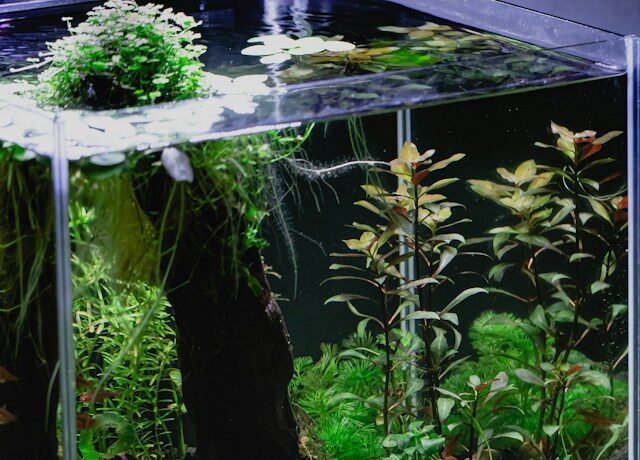Greetings from the amazing world of aquariums, where interesting undersea phenomena come to life! One thing is clear, whether you are an experienced fish hobbyist or are just getting started, a tiny aquarium pump can be your greatest friend. Your fish tank’s health and vitality are greatly dependent on these small but powerful gadgets, which help your aquatic buddies flourish in their safe refuge. We’ll examine the advantages of using a tiny aquarium pump in this blog post, along with some crucial considerations to make when selecting one for your priceless aquatic ecosystem.

Use of a Small Aquarium Pump Has Advantages
There are several advantages that a small aquarium pump can provide for your fish tank design. The following are some benefits of employing this necessary piece of equipment:
- Better Water Circulation: A modest aquarium pump makes sure that your tank’s water is evenly distributed and that all of the nutrients and oxygen it contains are reached. This is particularly necessary for larger tanks or ones with various decorations and plants.
- Enhanced Filtration: To maintain clean, clear water, the pump cooperates with your filtration system. It assists in keeping your aquatic pets’ water quality at its best by clearing the tank of trash, uneaten food, and debris.
- Preventing Dead Zones: Poor circulation can lead to stagnant zones in some parts of the tank, which can harm your fish’s health and the water’s quality. You may steer clear of these dead zones and encourage a generally healthier environment by utilising a modest aquarium pump.
- Oxygenation: Fish need a lot of oxygen to survive, especially in tanks with a lot of live plants or fish. Increased gas exchange at the water’s surface is made possible by the pump’s movement, which guarantees a sufficient supply of oxygen.
- Temperature Regulation: By distributing heat more uniformly across the water column, several pumps have functions that aid in controlling aquarium temperature. This can be especially helpful if you reside somewhere where there are regular temperature swings.
Things to Take Into Account While Selecting a Small Aquarium Pump
Selecting the ideal tiny aquarium pump is essential to keeping your fish tank healthy and flourishing. It can be difficult to decide which of the various options available is best for your needs. Here are a few important things to think about before choosing.
You must ascertain the dimensions and water capacity of your aquarium. This will help you choose a pump with the proper flow rate. As a general guideline, the pump ought to move four times as much water through your tank in an hour.
Next, think about how noisy the pump is. Certain pumps have a lot of noise, which might disturb the tranquillity of both you and your fish. Seek out models that are especially made to run quietly.
The efficient use of energy is another crucial component. Choosing an energy-efficient pump will lower its impact on the environment in addition to saving you money on electricity costs.
Furthermore, see if the pump has flow control valves or adjustable settings. This enables you to control the flow of water according to certain needs, like temperature or oxygen concentration.
Think about whether you need extra features like UV sterilisation or built-in filtration. These added features might reduce maintenance requirements and improve the quality of the water.
Before deciding on a pump, read reviews from other aquarium lovers who have tried comparable models. Their experiences can offer insightful information about functionality, robustness, and general customer happiness.

Advice for Appropriate Upkeep and Handling
After learning the advantages of utilising a tiny aquarium pump, it’s critical to grasp how to take good care of and maintain this vital piece of machinery. You can make sure that your little aquarium pump keeps functioning at its best for many years to come by paying attention to these pointers.
- Regular Cleaning: The effectiveness of your tiny aquarium pump may be impacted over time by the buildup of dirt and algae. It is essential to clean the pump on a regular basis by clearing the intake and output sections of any dirt or debris. Utilise water, a suitable cleaning solution, a soft brush, or both as advised by the manufacturer.
- Examine the Impeller: The pump’s impeller generates the water flow. It is essential to regularly inspect it for any indications of damage or blockage brought on by gravel or dirt particles. If required, gently remove the impeller, give it a thorough cleaning, and make sure it spins freely before putting it back together.
- Maintain Water Quality: Water quality needs to be high for a fish tank to be healthy. Test the pH, ammonia, and nitrate levels in your tank on a regular basis using the suitable testing kits that pet retailers sell. Depending on what your fish species requires, make sure the filter is working properly and replace the water frequently.
- Avoid Overheating: Because small aquarium pumps produce heat when they work, it’s important to have enough ventilation around them to avoid overheating problems, which could endanger the health of your fish and the pump itself. Avert obstructing the airflow vents or placing anything directly on top of the pump.
- Examine Hoses and connectors: Make sure your small aquarium pump system is free of leaks or other damage that could reduce its efficiency by routinely checking all of the hoses, connectors, seals, and valves that are connected to it.





